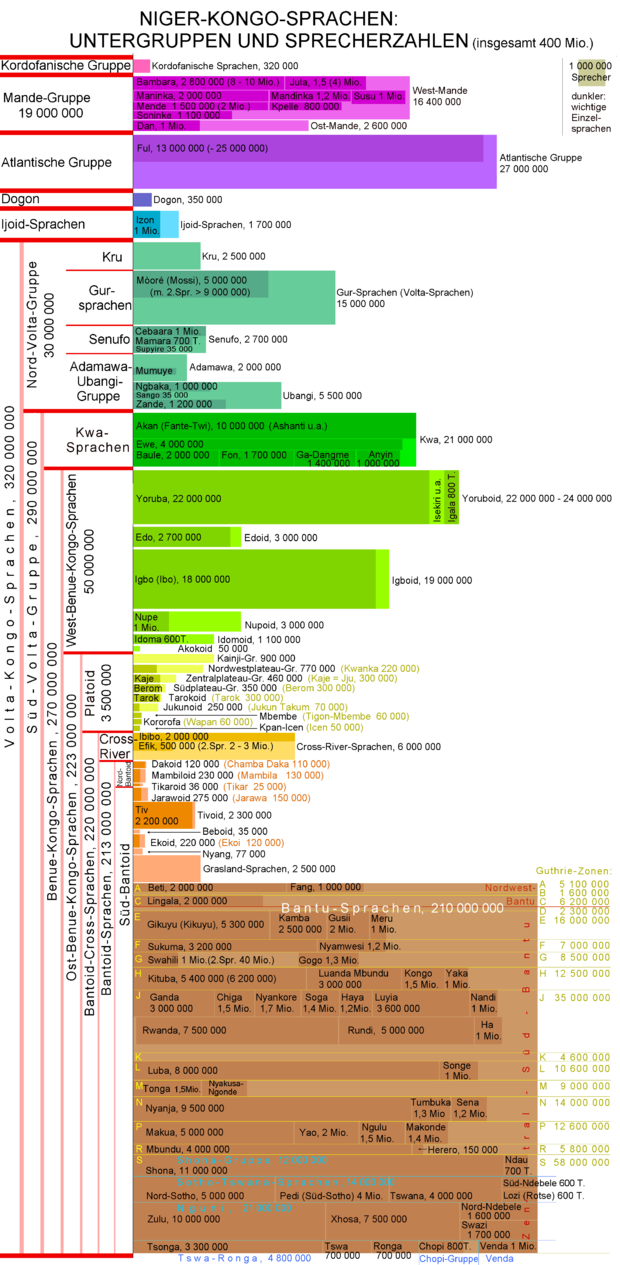Volta Congo languages
The Volta Congo is by far the largest and most complex primary branch of the Niger Congo . The approximately 1250 Volta Congo languages are spoken by around 320 million people in West , Central and all of South Africa . They also include the Bantu languages with over 200 million speakers.
North and South Volta Congo
Volta-Congo consists of the two main branches North-Volta-Congo with 280 languages and 30 million speakers and the significantly larger South-Volta-Congo (also Kwa-Benue-Congo ) with almost a thousand languages and about 300 million speakers, to which also the Bantu languages belong.
North Volta-Congo is divided into the branches Kru , Gur , Senufo and Adamawa-Ubangi . The languages of these branches are spoken in West Africa from Liberia to Cameroon . South Volta Congo, which is about ten times as large in terms of its number of speakers, has the main units Kwa (the western Kwa after Greenberg) and Benue Congo , which in turn is divided into West Benue Congo (Greenberg's East Kwa ) and East Benue Congo ( Benue-Kongo after Greenberg) disintegrates. Whether the Benue-Congo languages as a whole - as generally accepted since Greenberg and presented in Bendor-Samuel 1989 - form a valid genetic unit has not yet been clearly clarified.
The approximately 75 (western) Kwa languages are spoken by 21 million in the states of Ivory Coast , Ghana , Togo , Benin and Nigeria . West Benue Congo (consisting of Yoruboid, Edoid, Igboid, Nupoid, Idomoid and smaller groups) is spoken in Togo, Benin and South Nigeria (73 languages with 48 million speakers), East Benue Congo has a total of around 800 Languages with 225 million speakers and is divided into the two main groups of Platoids (including Kainji, Plateau languages, Tarokoid, Jukunoid) and Bantoid cross-languages . The Cross River includes around 70 languages with 6 million speakers; they are spoken in southeast Nigeria and Cameroon . The Bantoid languages include all around 500 Bantu languages , plus some groups spoken in southern Nigeria and Cameroon (Jarawoide, Tivoide, Ekoide, grassland and other languages) that are closely related to the Bantu languages.
Further details about the Volta-Congo and its sub-groups can be found in the following classification, the tabular overview (number of languages and speakers, geographical distribution) and the articles on the sub-units of the Volta-Congo.
Classification of the Volta Congo
The classification of the Volta-Congo is based on Heine-Nurse 2000:
-
Volta Congo
-
North Volta Congo
- Kru
- Gur (Voltaic)
- Senufo
- Adamawa-Ubangi
-
South Volta Congo or Kwa Benue Congo
- Kwa
-
Benue Congo
- West Benue Congo
-
East Benue Congo
- Platoid or Central Nigerian
- Bantoid Cross
-
North Volta Congo
It can be seen that the large group of Bantu languages genetically represents only a sub-sub-unit within the Niger-Congo and Volta-Congo.
The subgroups of the Volta-Congo
The following table contains the number of languages and speakers as well as the main distribution areas for the larger subgroups of the Volta Congo.
| Sub-branch | Number of languages |
Number of speakers |
Main distribution area |
|---|---|---|---|
| Kru | 29 | 2.3 million | Ivory Coast, South Liberia |
| Gur (Voltaic) | 74 | 15 million | Mali, Ivory, Burkina Faso, Ghana, Togo, Nigeria |
| Senufo | 15th | 2.7 million | Burkina Faso, Ivory Coast, Mali, Ghana |
| Adamawa-Ubangi | 158 | 7.6 million | Nigeria, Cameroon, Central Africa, Chad, Sudan |
| Kwa | 75 | 21 million | Ivory Coast, Ghana, Togo, Benein, Nigeria |
| Yoruboid | 14th | 22 million | Southwest Nigeria, Benin, Togo |
| Edoid | 26th | 2.6 million | Central-South Nigeria |
| Igboid | 7th | 19 million | Southeast Nigeria |
| Nupoid | 11 | 3 million | West-Central Nigeria |
| Idomoid | 9 | 1.1 million | South Nigeria |
| Kainji | 54 | 1 million | Northwest and North-Central Nigeria |
| plateau | 43 | 2 million | North-Central Nigeria ( no genetic unit ) |
| Cross river | 65 | 5.6 million | Nigeria: Cross River State; Cameroon |
| Dakoid | 3 | 0.5 million | East Nigeria |
| Tivoid | 18th | 2.4 million | East Nigeria, West Cameroon |
| Grasslands | 67 | 2.5 million | West Cameroon |
| Bantu | 487 | 210 million | all of central and southern Africa |
The term X-oid denotes a main language X with its closely related sister languages. For example, Igboid is the group of languages directly related to Igbo . As a rule, it is a dialect continua . Some researchers also consider such groups to be a single language.
Linguistic properties
For the linguistic properties of the Volta-Congo languages, see the article Niger-Congo languages and the articles on the subunits.
literature
- Joseph Greenberg: The Languages of Africa. Mouton, The Hague and Indiana University Center, Bloomington 1963.
- Bernd Heine and others (ed.): The languages of Africa. Buske, Hamburg 1981.
- Bernd Heine and Derek Nurse (eds.): African Languages. An Introduction. Cambridge University Press 2000.
- John Bendor-Samuel (Ed.): The Niger-Congo Languages: A Classification and Description of Africa's Largest Language Family. University Press of America, Lanham, New York, London 1989.
Individual evidence
- ↑ Ernst Kausen, The Classification of the Volta-Congo Languages within the Niger-Congo ; .doc, accessed on March 26, 2011

